
Walk Walk Dance (2021) by Daily tous les jours. Photo credit: Jack Landau.
There are now more than 25 so-called “infrastructure parks” in North America, the most well-known of which is New York’s High Line. Public art commissions—both temporary and permanent—can help draw attention to the boundaries of what we identify as ‘infrastructure’ and the space we label ‘park,’ and indeed, the most successful of these are those that provide leisure space for city dwellers and tourists while also fostering a conversation about the nature of urban form. A case in point is Canada's Bentway, which opened to the public in 2018. The mile-long Toronto park is pierced by half a dozen streets running north from Lake Ontario..
Located below the busy Gardiner Expressway, The Bentway is the primary recreational space for some 200,000 people living in adjacent vertical communities. The Bentway Conservancy, which administers the park’s public art programs, has commissioned a number of (primarily Canadian) artists, set designers, and dancers to test out a series of engaging questions and ideas on the site. From its inception, the Conservancy has commissioned artists and event sponsors who actively engage with park users, whether through dance, sports, or even dining events. MacArthur-winner Mimi Lien installed a parade of bright traffic signs; choreographer Noémie LaFrance designed a “deambulatory” performance on a walkway; and sculptor Esmaa Mahmoud built a colorful (and invitingly-skewed) basketball court.
Similar, important questions run through each commission: how can artists collaborate with citizens to create inclusive, meaningful urban space? And who really owns the park?
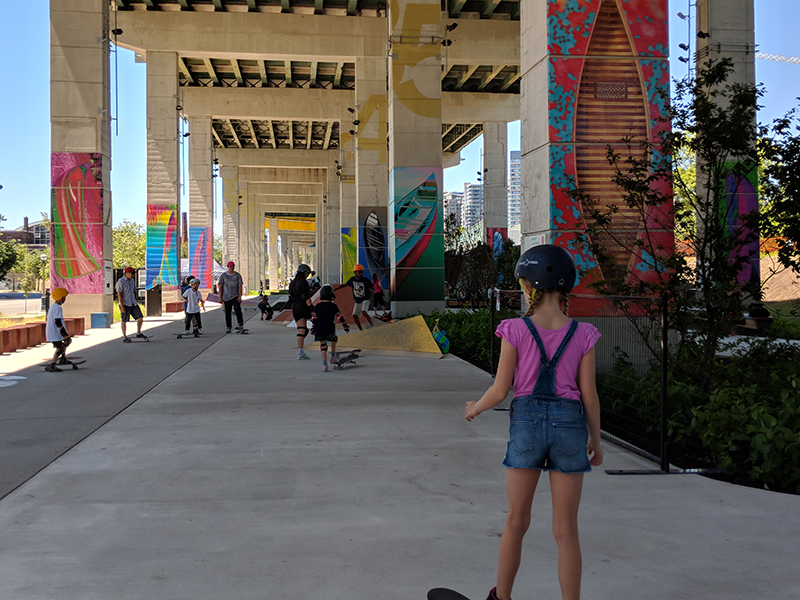
Dana Claxton, Forest of Canoes, 2018. Photo credit: Nicole Pacampara. Children move in all directions while the boats in Dana Claxton’s colorful canoes are mounted on the vertical ‘bents’ under the Gardiner Expressway. The space becomes an ice-covered rink in the wintertime, with accessible skate rental facilities in a nearby building.
Vancouver-based artist Dana Claxton received the first commission for “A Forest of Canoes,” a colorful installation which draws attention to Toronto’s submerged waterways and acknowledges the location of the park on unceded Indigenous territory. The images offer a stirring reminder of the ongoing conflicts between Indigenous and settler cultures, particularly in matters of access, navigation, and land use.
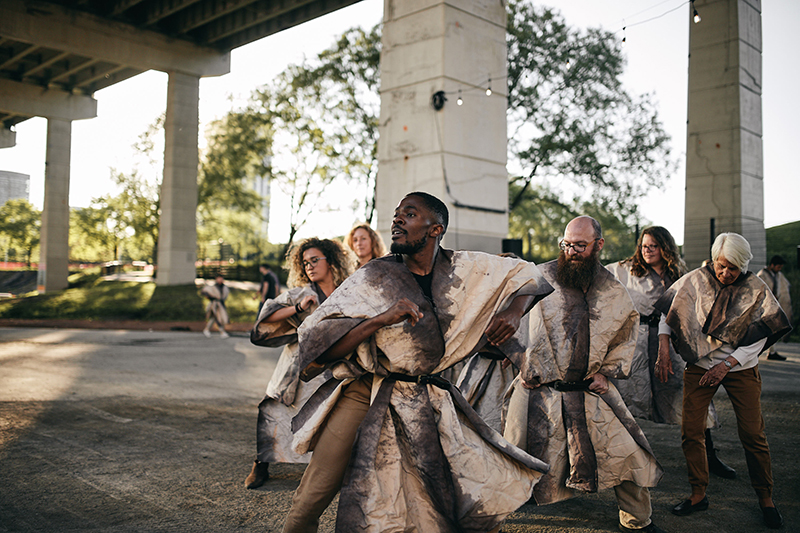
Noémie LaFrance, Dérives, 2019. Photo credit: SeeWhatlcy. Noémie LaFrance invited visitors and professional dancers to plumb the psycho-geography of The Bentway.
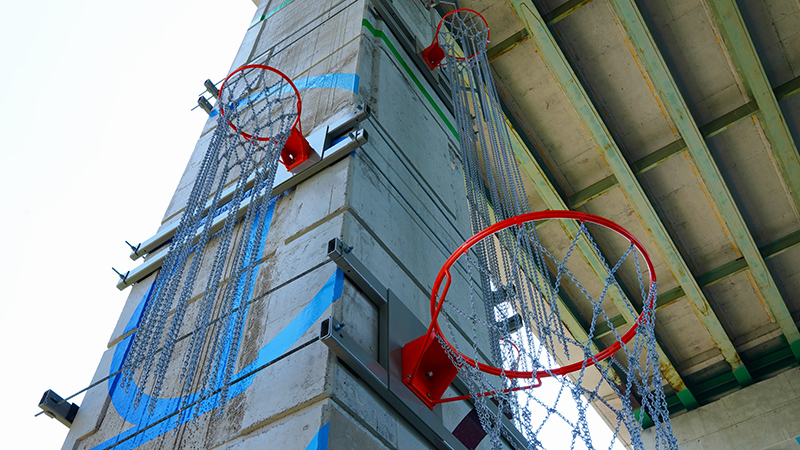
Esmaa Mohamoud, DoubleDribble, 2021. Close-up of three hoops. Photo credit: Julian Romano. Esmaa Mohamoud is known for powerful gallery installations highlighting racial inequality in professional sports. At The Bentway, Mohamoud dissects the spaces of the basketball court, while allowing young (and old) visitors to score new goals, or enjoy roller-skating on a summer day.
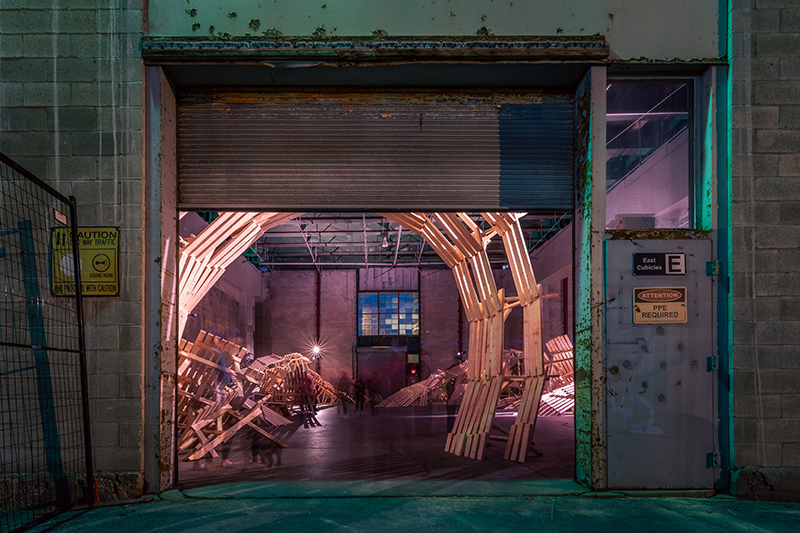
Striped Canary’s ‘Confluence’. Photo credit: Jack Landau.
Recently, the Bentway added indoor exhibition space to its holdings, carving a magnificent gallery from underused municipal storage space. The Maine-based duo Striped Canary created a long, meandering timber sculpture. ‘Confluence’—which began as a riff on The Bentway’s picnic tables and later morphed into a sinuous indoor-outdoor beast—reaches its curling conclusion inside the new space.
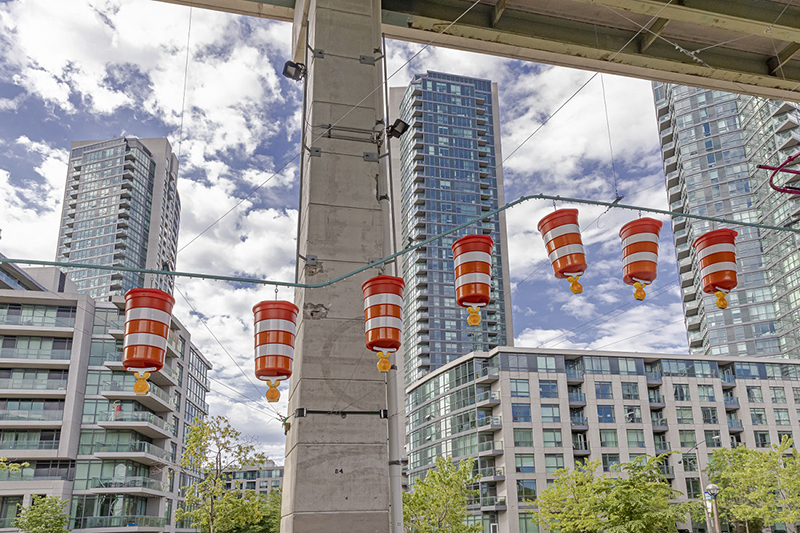
Mimi Lien, Parade, 2022. Photo credit: Toni Hafkenscheid
In the summer of 2022, set designer Mimi Lien introduced a particularly memorable kinetic installation. Using an oversized automated garment conveyor mechanism, she hijacked what might be called the Bentway’s clerestory space, installing a colorful parade of upside-down traffic pylons and street signs above its pathways. The fun, clattering effect decorated the park while also bringing into question the traditional means of marking infrastructure interventions in urban space.
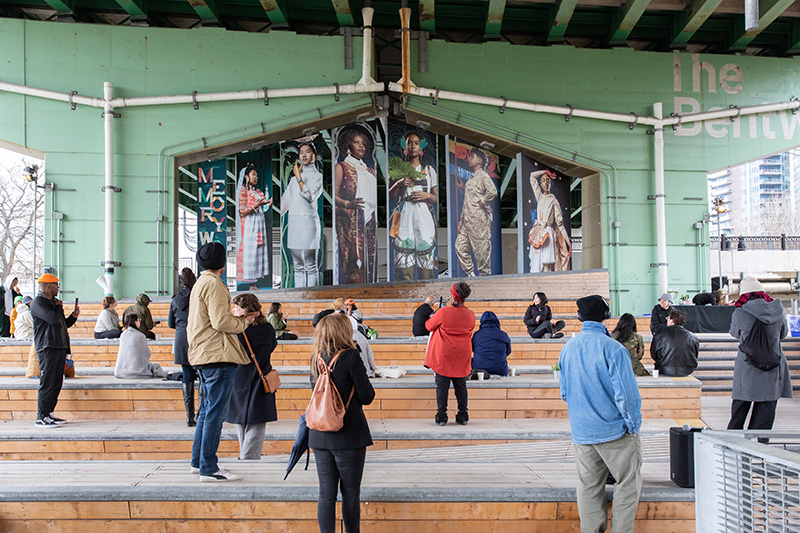
Memory Work Collective, “Memory Work”. Photo credit: Samuel Engelking
Another recent commission melds past and future, providing a beautiful backdrop for the social seating area at the park’s Strachan Gate entrance. Framed by a low green bent, “Memory Work” is a “speculative monument” to Toronto’s open-ended future. (One panel features OCAD’s Dean Dori Tunstall; whose forthcoming book Decolonizing Design may prove instrumental in shaping that future).
By commissioning installations that focus on the material past, present, and future of the site, the Bentway Conservancy is supporting a conversation about art, infrastructure, and urbanism likely to reach far beyond the shores of Lake Ontario.
The Bentway is free and open to the public. The Bentway Conservancy offers a public space fellowship and a Placemaking Internship.
